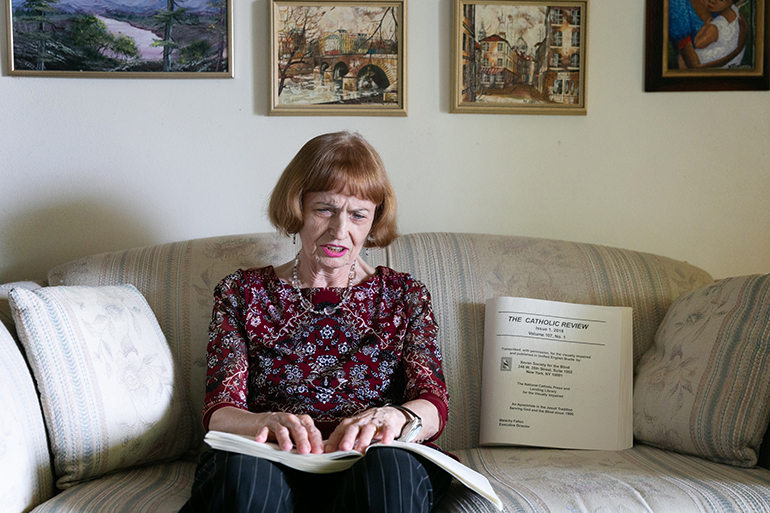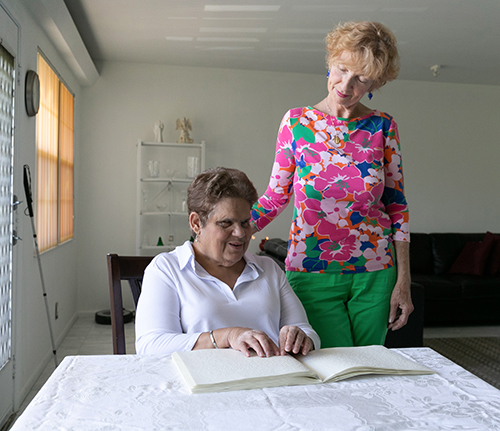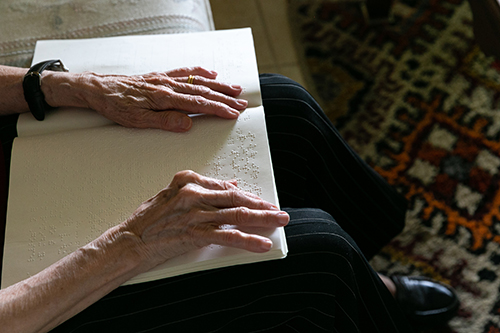By Tom Tracy - Florida Catholic

Photographer: TOM TRACY | FC
Cuban-American Adelina Maideski, a former gift store employee at Miami International Airport who attends St. Martha Parish in Miami Shores, reads braille Catholic materials at her residence.
COCONUT CREEK | In relocating to the area recently, Coconut Creek resident Lygia Bohan figures she misplaced her beloved childhood Catholic prayer book, written in Braille. She hopes, for sentimental reasons, it will eventually turn up.
Now a regular attendee at All Saints Parish in Sunrise, the New York-area native has been blind since childhood back in an era when some premature babies were exposed to unregulated oxygen levels in their incubators, causing permanent damage to their sight. The condition is called retrolental fibroplasia (RLF) and Terry syndrome. The oxygen therapy was used due to the premature development of their lungs.
“In elementary school I went to Lavelle School for the Blind in the Bronx, and that is where I was taught about the Catholic religion,” Bohan said. “That is where they gave me a Braille prayer book, and I loved that book, and I must have lost it in the move some years ago.”
Bohan reads along with the Sunday Mass and other Catholic publications in especially prepared Braille materials provided by the Xavier Society for the Blind. But she also makes use of the same array of digital communications tools that have enhanced modern life for everyone.

Photographer: TOM TRACY | FC
Coconut Creek resident Lygia Bohan, seated, who attends All Saints Parish in Sunrise, reads Catholic materials in braille, including the Sunday Mass readings which she reviews in advance of attending church. With her is Lighthouse Point resident and longtime disabilities advocate Dolores Hanley McDiarmid, who attends St. John the Baptist Church in Fort Lauderdale.
“I listen to the radio, and on the Internet I can get things,” she said. “I have an iPhone and can access audio programs there, things through streaming media.”
Malachy Fallon, executive director of the New York-based Xavier Society since 2016, noted some of the even newer technological advances that are specifically enhancing religious education and other materials for vision-impaired Catholics.
Xavier Society is a longtime publisher of the Mass Proper and various Catholic books and religious magazines in Braille, including the Catechism of the Catholic Church. It distributes those materials freely to vision-impaired Catholics throughout the country and relies on donations for its ministry.
“Not everyone has one but with a refreshable Braille display you can download a Braille Ready file (BRF) to your BRF device and it can be read on the display as refreshable Braille, and that is a great way for us to reach more people and use technology,” said Fallon.
Another tool that Xavier hopes to use to expand its reach is through an audio player-reader system developed by the National Library Service for the Blind and Physically Handicapped, which provides its reader devices for free along with their audiobook offerings � but in a cartridge format that is not yet compatible with the CD form of audio book materials in the Xavier Society collection.
Xavier has purchased a software license to use the new technology and is exploring an operational plan to convert its Catholic materials over to the compatible digital form used by the National Library Service, according to Fallon.
“Half a million Americans have those readers; it is very easy for someone to use compared to our current technology of using CDs,” he said. “The new technology is more flexible in terms of moving around in the book and all sorts of (navigational) things a reader with vision wouldn’t think about. The way the cartridges and content is formatted makes it easier to use.”
Other new-technology tools available to the vision-impaired include an array of personal computer software options for accessing, navigating and consuming general content on the Internet, with all its potential.
While younger Catholics with vision-impairment may be quick to tap into the expanding technological developments, older or retired Catholics with blindness � or those living alone or in out-of-the-way places � are often less likely to access and acquire technology and may have difficulty downloading related content.
“It would be great if everyone could download our BDF file but we still print 800 Mass Propers for four weeks of Masses at a time, with 750,000 pages of Braille created annually,” Fallon noted. Braille books can often cost upwards of $500 and take six months to produce.

Photographer: TOM TRACY | FC
Cuban-American Adelina Maideski, a former gift store employee at Miami International Airport who attends St. Martha Parish in Miami Shores, reads braille Catholic materials at her residence.
Xavier Society maintains an in-house transcriber as well as a working relationship with the National Braille Press in Boston, which produces and distributes some of the larger runs of its religious education materials and publications. That includes textbooks and workbooks for children in religious education programs.
According to the Florida Association of Agencies Serving the Blind, there are 58,000 legally blind or low vision persons in Miami-Dade County, and some 42,380 in Broward County.
In Miami Shores, Adelina Maideski, a retire drug store worker at Miami International Airport, recalls having poor vision as a youngster in Cuba, where she worked with a congregation of religious women until the Castro Revolution prompted her to leave with the nuns for North America.
Special glasses and contact lenses helped Maideski manage life first in Illinois and then Florida but she gradually began losing her vision during adulthood, forcing her to quit working in 1998.
With the help of the Lighthouse of Broward, a Fort Lauderdale-based educational and resource center for the blind, she learned to read Braille.
“I knew very little about the computer, but was fascinated with Braille and I did three books very very fast and I took a lot of courses, using large print and Braille materials from the library,” said Maideski, who subscribes to Xavier Society materials, including their Catholic Review magazine and the Mass Proper. She attends St. Martha Church in Miami Shores.
“Before I was only listening to the priests and the Mass readers, and now I can read,” Maideski said. “I don’t go to Mass every day but when Sunday and holy days come I already know what prayers and readings and Gospels will be, especially through reading that in the evening beforehand.”
Reflecting on the Braille Mass Proper that Xavier Society provides, she added, “If I don’t have that I would be lost, because I don’t see anything at all.”

